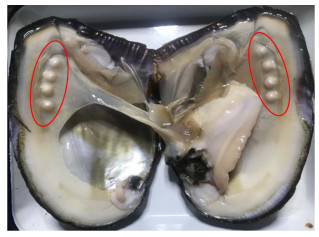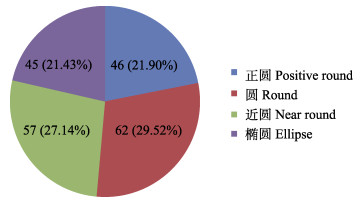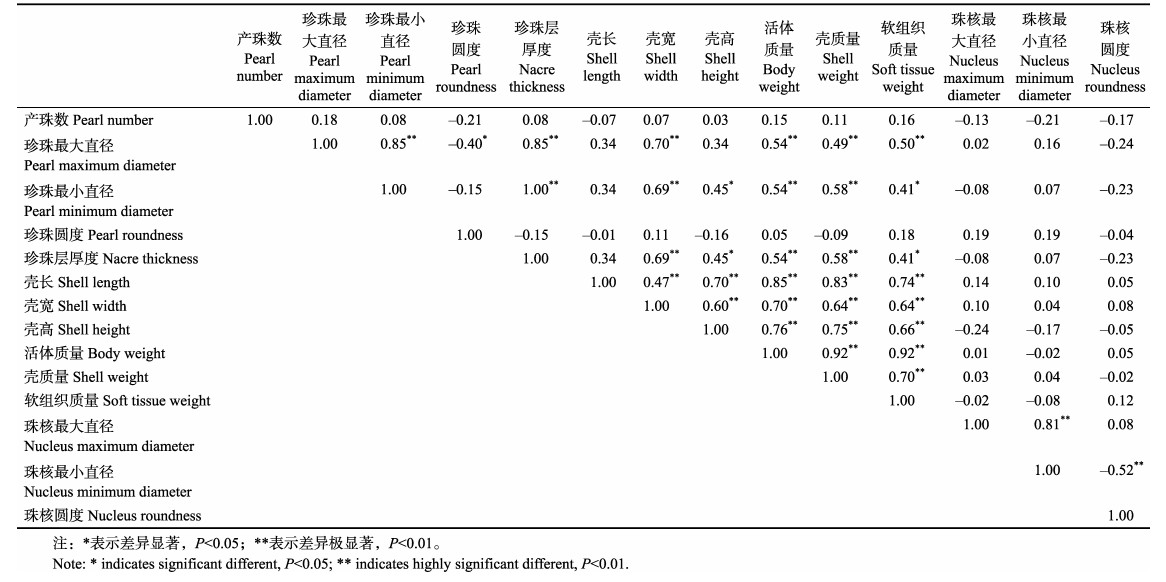2. 上海海洋大学 上海市水产动物良种创制与绿色养殖协同创新中心 上海 201306;
3. 无锡金珍珠科技有限公司 江苏 无锡 214000
2. Shanghai Collaborative Innovation Center for Cultivating Elite Breeds and Green-Culture of Aquaculture Animals, Shanghai Ocean University, Shanghai 201306, China;
3. Wuxi Golden Pearl Technology Co., Ltd, Wuxi 214000, China
我国珍珠产业长期处于“高产量,低产值”的困境(Cartier et al, 2013; 李家乐等, 2019; 孙朝虎等, 2019)。自20世纪80年代,我国珍珠总产量持续位居世界第一,甚至占到世界珍珠总产量的90%以上。然而,由于珍珠品质(如大小、形状)总体不高、加工技术相对落后,导致产值较低,仅占世界珍珠行业总产值的20%。从我国珍珠的组成来看,淡水珍珠占据绝对的优势(李家乐等, 2019)。据《2022中国渔业统计年鉴》统计,我国淡水珍珠养殖产量为475 086 kg,是海水珍珠养殖产量的237倍(农业农村部渔业渔政管理局等, 2022),淡水珍珠品质提升对于提高我国珍珠产值具有重要意义。
我国淡水珍珠养殖以传统的无核珍珠为主,面临着养殖周期长(3~5年)、高品质珍珠形成比例低(据不完全统计,珍珠正圆率仅为1%左右)等问题(梁飞龙等, 2015; 李家乐等, 2019)。近年来,随着内脏团有核淡水珍珠培育技术的突破(殷浩等, 2015; Yan et al, 2022; 郭柏莹等, 2023),如以三角帆蚌(Hyriopsis cumingii)“申紫1号”为育珠蚌培育大规格、高品质的珍珠得到了较快发展(殷浩等, 2015),可是产珠数量相对较低(每个育珠蚌只插1颗珠核)。新兴的以三角帆蚌为育珠蚌的外套膜有核珍珠培育,有望克服上述瓶颈难题(林伟财等, 2016; Gao et al, 2022):单个育珠蚌可插10颗珠核,养殖周期一般为1~2年,珍珠品质总体较高,外形酷似Akoya珍珠,市场上被称为“淡水Akoya”,价格也是常规珠的数倍(Gao et al, 2022)。可是,外套膜有核珍珠的培育方法尚不成熟,也缺乏针对性的品质评价体系。
鉴于此,本研究拟开展三角帆蚌外套膜有核珍珠关键质量性状(产珠数/成珠率、最大直径、最小直径、圆度、珍珠层厚度)与育珠蚌生长性状(壳长、壳宽、壳高、活体质量、壳质量、软组织质量)、珠核(最大直径、最小直径、圆度)的相关及通径分析,以期为外套膜有核珍珠培育及品质提升提供科技支撑。
1 材料与方法 1.1 外套膜有核珍珠培育与采收于2021年5月,选择2龄“申浙3号”三角帆蚌进行外套膜植核,珠核规格为5 mm [最大直径为(4.77±0.16) mm,最小直径为(4.71±0.19) mm,圆度为(1.46±2.44)%],每侧外套膜各植入5颗珠核(每蚌共植入10颗珠核),养殖于上海海洋大学实验基地直至形成商品珠,并于2022年12月(培育周期为19个月)进行采收(图 1)。

|
图 1 三角帆蚌所产外套膜有核珍珠 Fig.1 Nucleated pearls from the mantle of H. cumingii |
在采收的育珠蚌中随机挑选30个,经清洗后,用游标卡尺(精确度为0.01 mm)测定其壳长、壳宽和壳高(图 2),并用电子天平(精确度为0.01 g)测定其活体质量。然后,逐一解剖分离出珍珠、软组织和贝壳。用电子天平进一步称量软组织和贝壳的质量。育珠蚌的生长性状见表 1。

|
图 2 三角帆蚌壳长、壳宽和壳高测量示意图 Fig.2 The measurement of shell length, width and height of H. cumingii |
|
|
表 1 育珠蚌的生长性状(n=30) Tab.1 Growth traits of the pearl-bearing mussels (n=30) |
对每个育珠蚌采收的珍珠进行数量统计和清洗。在此基础上,计算成珠率(段胜华等, 2020):
| $ 成珠率(\%)=\frac{单个育珠蚌产珠数}{植入珠核数}\times 100 $ | (1) |
然后,使用游标卡尺测定其最大直径和最小直径。根据我国珍珠品质鉴定评价国家标准《珍珠分级》(GB/T 18781-2008),以珍珠最小直径表示其大小;以珍珠最大和最小直径差与其均值的百分比表示其圆度(R,%) (Li et al, 2017; 段胜华等, 2020),即:
| $ R(\%) = \frac{{{d_{{\text{max}}}} - {d_{{\text{min}}}}}}{{{d_{{\text{ave}}}}}} \times 100 $ | (2) |
式中,dmax为最大直径,dmin为最小直径,dave为最大直径和最小直径的平均值。R值越小表示圆度越高。
此外,根据珍珠大小和珠核规格,计算出珍珠的珍珠层厚度(mm):
| $ 珍珠层厚度(\text{mm})=珍珠最小直径-珠核最小直径 $ |
鉴于我国尚没有评价淡水有核珍珠圆度和珍珠层厚度级别的国家标准,因此,本研究参考《珍珠分级》(GB/T 18781-2008)中海水(有核)珍珠的圆度划分标准(直径差百分比≤1.0%为正圆;≤5.0%为圆;≤10.0%为近圆;> 10.0%为椭圆)和珍珠层厚度级别划分标准(珠层厚度≥0.6 mm为特厚;≥0.5 mm为厚;≥0.4 mm为中;≥0.3 mm为薄;<0.3 mm为极薄)对淡水有核珍珠进行品质评价。
1.3 统计分析所有数据均以平均值±标准差(Mean±SD)表示。采用SPSS 24.0统计软件进行珍珠及其与育珠蚌和珠核数量性状之间Pearson相关分析和通径分析(张爱菊等, 2013; Chen et al, 2021; 张新明等, 2022)。P < 0.05表示差异水平显著;P < 0.01表示差异水平极显著。
此外,使用决定系数来评价自变量对因变量数量性状的决定程度。直接决定系数(di)和间接决定系数(dij)的计算公式分别为(Chen et al, 2021; 张新明等, 2022):
| $ {d_i} = {P_i}^2 $ | (3) |
| $ {d_{ij}} = 2{r_{ij}} \times {P_i} \times {P_j} $ | (4) |
式中,Pi为自变量i的直接作用,rij为自变量i和自变量j之间的相关系数,Pj为自变量j的直接作用。
2 结果 2.1 珍珠质量性状不同育珠蚌中外套膜有核珍珠的产珠数见表 2,对应的成珠率变化范围为50%~100%,其中,成珠率为70%的占比率最高(43.33%),而成珠率为50%和100%的占比最低(3.33%),平均成珠率为(70.00± 10.82)%。珍珠大小的变化范围为4.72~9.19 mm,平均为(6.91±0.67) mm (表 2)。珍珠圆度的变化范围为0~45.60%,平均为(6.74±7.78)% (表 2)。参考海水(有核)珍珠的形状划分标准,所产外套膜有核珍珠形状占比的从高到低的顺序依次为圆珠、近圆、正圆和椭圆(图 3)。珍珠层厚度的变化范围为0.01~4.48 mm,平均为(2.20±0.67) mm(表 2)。参考海水珍珠的珍珠层厚度级别划分标准,外套膜有核珍珠的珍珠层极薄占比1.43%,特厚占比98.57%。这些关键质量性状的变异系数均较大,其中,圆度和珍珠层厚度的变异系数最高(表 2)。
|
|
表 2 三角帆蚌产外套膜有核珍珠质量性状(n=210) Tab.2 Quantitative traits of nucleated pearls from the mantle of H. cumingii (n=210) |

|
图 3 不同圆度珍珠的数量及其比率 Fig.3 The number and ratio of pearls with different shapes |
如表 3所示,产珠数和珍珠圆度与珍珠、育珠蚌及珠核所有数量性状均不相关(P > 0.05)。珍珠大小与珍珠层厚度,育珠蚌的壳宽、活体质量和壳质量极显著相关(P < 0.01);与育珠蚌的壳高和软组织质量显著相关(P < 0.05)。珍珠层厚度与育珠蚌的壳宽、活体质量和壳质量极显著相关(P < 0.01);与育珠蚌的壳高和软组织质量显著相关(P < 0.05)。需要指出的是,相关分析检验的只是2个数量性状之间的关联程度,在具有多个数量性状存在(极)显著相关时,它只能反映其复合关系,而无法揭示自变量对因变量的作用原因和效应大小。因此,为进一步明确各自变量数量性状对因变量的重要性,需要在此基础上进行通径分析。
|
|
表 3 珍珠、育珠蚌和珠核数量性状之间的相关性 Tab.3 Correlation between quantitative traits of pearls, pearl-breeding mussels, and nuclei |
对珍珠质量性状中与育珠蚌、珠核具有(极)显著相关的珍珠大小和珍珠层厚度进行通径分析。以珍珠最小直径(y1)和珍珠层厚度(y2)为因变量,育珠蚌的壳长(x1)、壳宽(x2)、壳高(x3)、活体质量(x4)、壳质量(x5)、软组织质量(x6)以及珠核的最大直径(x7)、珠核最小直径(x8)、珠核圆度(x9)为自变量,进行逐步回归分析:
| $ y_{1} = 3.464 + 0.078x_{2} ‒ 0.055x_{9} (R^{2} = 0.75; P<0.01) $ |
| $ y_{2} = –1.243 + 0.077x_{2} ‒ 0.055x_{9} (R^{2} = 0.75; P<0.01) $ |
2个回归方程均在0.01水平显著,表明建立的回归方程有效,能够指导外套膜有核淡水珍珠的培育。
由表 4可知,育珠蚌壳宽对珍珠大小的直接作用最大,为0.69;珠核圆度对珍珠大小的直接作用为‒0.23。育珠蚌壳宽通过珠核圆度对珍珠大小的间接作用(0.05)明显大于珠核圆度对壳宽的间接作用(‒0.02)。此外,育珠蚌壳宽对珍珠层厚度的直接作用(0.69)亦大于珠核圆度对珍珠层厚度的直接作用(‒0.23)。育珠蚌壳宽通过珠核圆度对珍珠层厚度的间接作用(0.05)大于珠核圆度对壳宽的间接作用(‒0.02)。
|
|
表 4 育珠蚌和珠核对珍珠质量性状的直接及间接作用 Tab.4 Direct and indirect effects of mussels and nuclei on quanlity traits of pearls |
由表 5可见,育珠蚌壳宽对珍珠大小的直接决定系数(0.50)明显高于珠核圆度对珍珠大小的直接决定系数(0.08)以及育珠蚌壳宽通过珠核圆度对珍珠大小的间接决定系数(‒0.03)。育珠蚌壳宽和珠核圆度对珍珠层厚度的直接、间接决定系数亦表现出相同的趋势。
|
|
表 5 育珠蚌和珠核对珍珠质量性状的决定系数 Tab.5 Determinant coefficients of mussels and nuclei on quanlity traits of pearls |
以三角帆蚌为育珠蚌,培育有核珍珠(包括外套膜有核珍珠、内脏团有核珍珠)的产珠数/成珠率与育珠蚌的年龄、珠核规格和植核数量等因素密切相关(谢绍河等, 2015; 林伟财等, 2016)。林伟财等(2016)研究发现,在三角帆蚌外套膜有核珍珠培育中,2龄(85.0%)和3龄(80.0%)育珠蚌的成珠率显著高于4龄(70.0%)育珠蚌;植入规格为5 mm (94.0%)和6 mm (91.0%)珠核的成珠率显著高于植入规格为7 mm (80.2%)和8 mm (69.7%)珠核;植入10颗(88.0%)珠核的成珠率显著高于植入14颗(77.0%)和18颗(64.0%)珠核。此外,育珠蚌的年龄、珠核规格和植核数量等因素还会影响珍珠圆度(林伟财等, 2016)。2龄(26.0%)和3龄(23.5%)三角帆蚌培育外套膜有核珍珠的正圆珠显著高于4龄(16.0%)育珠蚌;植入规格为5 mm (38.0%)和6 mm (32.5%)珠核的正圆珠成珠率显著高于植入规格为7 mm (25.0%)和8 mm (20.6%)珠核;植入10颗(27.0%)珠核的正圆珠成珠率显著高于植入14颗(19.5%)和18颗(15.0%)珠核。本研究借鉴林伟财等(2016)的优选结果,选用2龄三角帆蚌为育珠蚌、珠核规格为5 mm、植入10颗珠核,与之相比,本研究的产珠数/成珠率和正圆珠比率均略低。这可能是由于林伟财等(2016)所用的三角帆蚌在育珠前已经过挑选(选择标准为蚌体宽、壳厚、年轮宽大、具有鲜艳的黄色软边、腹缘中间至出水口处饱满呈椭圆形,壳内珍珠层光泽艳丽,软体部健壮饱满、外套膜肥厚),而本研究未对三角帆蚌进行选择造成的,表明通过优化育珠蚌的生长性状能够提升外套膜有核珍珠的成珠率和圆度。
迄今,尚未发现三角帆蚌外套膜有核珍珠大小及珍珠层厚度的报道。研究表明,有核珍珠大小与其珍珠层厚度正相关(Li et al, 2017)。由于有核珍珠的不同培育方式(如外套膜有核珍珠、内脏团有核珍珠植入)又或同一种培育方式植入珠核的规格可能不一致,因此,无法直接通过珍珠大小来比较珍珠层厚度。然而,珍珠层厚度的增长速率是决定珍珠大小的重要因素。本研究中,外套膜有核珍珠的珍珠层厚度的平均增长速率为每年1.39 mm,明显高于三角帆蚌内脏团有核珍珠的每年0.71~0.77 mm的珍珠层厚度增长速率(Li et al, 2017)。根据我国珍珠品质鉴定评价国家标准《珍珠分级》(GB/T 18781-2008),在海水(有核)珍珠中,珍珠层厚度大于0.60 mm即被定义为“特厚”,因此,培育三角帆蚌外套膜有核珍珠可大幅缩短养殖周期,从而提高珍珠产值。
3.2 三角帆蚌外套膜有核珍珠品质提升技术珍珠的产珠数/成珠率及其品质与育珠蚌性状往往有着密切关系。尽管如此,本研究结果显示,三角帆蚌外套膜有核珍珠的产珠数与珍珠、育珠蚌及珠核所有数量性状均不相关。提示,产珠数可能更容易受到育珠蚌排异免疫反应的影响。研究表明,淡水(如三角帆蚌)和海水(如马氏珠母贝Pinctada fucata martensii、合浦珠母贝Pinctada fucata martensii)育珠蚌均会对植入的珠核产生排异反应(Fukushima et al, 2014; Huang et al, 2019; Jiao et al, 2019),从而导致育珠蚌的“吐核”或“吐珠”发生。珠核圆度能够在一定程度上影响珍珠圆度。然而,本研究发现,三角帆蚌外套膜有核珍珠圆度与珠核圆度之间无显著相关性,此外,与育珠蚌的形态和质量性状之间也没有显著相关性。李清清等(2015)研究发现,三角帆蚌产无核珍珠的圆度与育珠蚌的生长速率显著正相关。三角帆蚌生长率是否与外套膜有核珍珠圆度显著相关尚有待于进一步研究。
值得注意的是,三角帆蚌外套膜有核珍珠的大小与珍珠层厚度显著正相关,且珍珠大小和珍珠层厚度均与育珠蚌的壳宽、活体质量、壳质量、壳高和软组织质量极显著或显著相关。通径和决定程度分析进一步揭示,育珠蚌的壳宽以及珠核的圆度是决定三角帆蚌外套膜有核珍珠的大小及珍珠层厚度的关键性状。Lore等(2016)研究发现,珠母贝(Pinctada margaritifera)的壳宽是影响所产珍珠的珍珠层厚度的关键因素,二者之间呈显著正相关,这与本研究结果一致。然而,Li等(2017)研究显示,以三角帆蚌为育珠蚌培育内脏团有核珍珠,珍珠大小和珍珠层厚度与育珠蚌的壳长和壳质量等性状显著正相关,与壳宽并不相关。提示,三角帆蚌外套膜有核珍珠的形成特征较内脏团有核珍珠具有特异性。在培育三角帆蚌外套膜有核珍珠的实际生产中,通过选取壳更宽的育珠蚌,并选用圆度更高的珠核,应该能增加珍珠大小及其珍珠层厚度,从而提高珍珠品质。
4 结论以三角帆蚌为育珠蚌,进行为期19个月的外套膜有核珍珠培育(珠核规格为5 mm,植入10颗珠核),平均成珠率为70.00%,珍珠平均大小为6.91 mm,珍珠层平均厚度为2.20 mm,正圆率为21.90%。三角帆蚌外套膜有核珍珠的大小、珍珠层厚度与育珠蚌壳宽及珠核圆度显著正相关。壳宽对珍珠大小和珍珠层厚度的直接、间接作用及决定系数均明显大于珍珠层厚度。在培育三角帆蚌外套膜有核珍珠的实际生产中,通过提升育珠蚌的壳宽和珠核圆度有望提高珍珠的大小和珍珠层厚度等品质。
Bureau of Fisheries, Ministry of Agriculture and Rural Affairs, National Fisheries Technology Extension Center, China Society of Fisheries. China fishery statistical yearbook 2022. Beijing: China Agriculture Press, 2022 [农业农村部渔业渔政管理局, 全国水产技术推广总站, 中国水产学会. 2022中国渔业统计年鉴. 北京: 中国农业出版社, 2022]
|
CARTIER L E, ALI S H. China´s pearl industry: An indicator of ecological stress. Journal of the Gemmological Association of Hong Kong, 2013, 34: 18-21 |
CHEN Y H, LI H Y, DING H B, et al. Heritability estimation and path analysis for growth traits of the razor clam Sinonovacula constricta under high salinity. Aquaculture, 2021, 545: 737175 DOI:10.1016/j.aquaculture.2021.737175 |
DUAN S H, LIU Z M, HU H H, et al. Growth traits of pearl mussels and pearl formation percentage and size of non-nucleated pearl after graft operation. Journal of Fisheries of China, 2020, 44(10): 1645-1653 [插片后珍珠蚌生长性状及其无核珍珠成珠率和大小. 水产学报, 2020, 44(10): 1645-1653 DOI:10.11964/jfc.20190911977] |
FUKUSHIMA E, IWAI T, MIURA C, et al. A xenograft mantle transplantation technique for producing a novel pearl in an akoya oyster host. Marine Biotechnology, 2014, 16: 10-16 DOI:10.1007/s10126-013-9525-0 |
GAO J, ZHANG J, WU W, et al. Synchrotron radiation μ-XRF imaging reveals Mn zoning in freshwater pearls. Journal of Physical Chemistry C, 2022, 126(50): 21381-21389 DOI:10.1021/acs.jpcc.2c05988 |
GUO B Y, LI X, WANG H, et al. Identification of Hc-GSK3β gene and screening of SNPs related to inner shell color of Hyriopsis cumingii. Acta Hydrobiological Sinica, 2023, 47(4): 602-608 [三角帆蚌Hc-GSK3β基因鉴定及内壳色性状相关SNP筛选. 水生生物学报, 2023, 47(4): 602-608] |
HUANG D D, SHEN J X, LI J L, et al. Integrated transcriptome analysis of immunological responses in the pearl sac of the triangle sail mussel (Hyriopsis cumingii) after mantle implantation. Fish and Shellfish Immunology, 2019, 90: 385-394 DOI:10.1016/j.fsi.2019.05.012 |
JIAO Y, YANG S, CAO Y F, et al. Genome and transcriptome analyses providing insight into the immune response of pearl oysters after allograft and xenograft transplantations. Fish and Shellfish Immunology, 2019, 90: 109-117 DOI:10.1016/j.fsi.2019.04.061 |
LI J L, WANG D F, BAI Z Y, et al. China freshwater pearl culture industry development report. China Fisheries, 2019(3): 23-29 [中国淡水珍珠养殖产业发展报告. 中国水产, 2019(3): 23-29] |
LI Q Q, BAI Z Y, LIU X J, et al. Correlation analysis of non-nucleated pearl quality parameters with growth traits and inner shell color of Hyriopsis cumingii. Journal of Fisheries of China, 2015, 39(11): 1631-1639 [三角帆蚌生长性状和内壳色与所产无核珍珠质量的相关性分析. 水产学报, 2015, 39(11): 1631-1639 DOI:10.11964/jfc.20150309798] |
LI Q Q, BAI Z Y, HAN X K, et al. Freshwater nucleated pearl quality is influenced by host mussel growth traits in Hyriopsis cumingii. Aquaculture Research, 2017, 48(9): 4656-4665 DOI:10.1111/are.13288 |
LIANG F L, XIE S H, LIN W C. Progress on pearl production from Hyriopsis cumingii. Transactions of Oceanology and Limnology, 2015(2): 113-118 [三角帆蚌人工育珠研究进展. 海洋湖沼通报, 2015(2): 113-118] |
LIN W C, WANG Q G, XIE S H, et al. Study on pearl cultivation techniques of nucleated pearl from the mantle of Hyriopsis cumingii. Transactions of Oceanology and Limnology, 2016(5): 99-103 [三角帆蚌外套膜有核珍珠培育技术研究. 海洋湖沼通报, 2016(5): 99-103] |
LORE L P, SOPHIE P, MANAARII S K, et al. Culture site dependence on pearl size realization in Pinctada margaritifera in relation to recipient oyster growth and mantle graft biomineralization gene expression using the same donor phenotype. Estuarine, Coastal and Shelf Science, 2016, 182: 294-303 DOI:10.1016/j.ecss.2016.03.009 |
SUN Z H, BAI Z Y, LI Q Q, et al. The Optimization of early compound selection for growth traits and shell color in Hyriopsis cumingii. Progress in Fishery Sciences, 2019, 40(2): 91-97 [三角帆蚌生长和壳色性状早期复合选择的优化研究. 渔业科学进展, 2019, 40(2): 91-97 DOI:10.19663/j.issn2095-9869.20180201001] |
XIE S H, LIN W C, LIANG F L, et al. A preliminary methodological study on pearl production by nucleating the visceral mass of Hyriopsis cumingii. Transactions of Oceanology and Limnology, 2015(4): 27-32 [三角帆蚌内脏团植核育珠技术的初步研究. 海洋湖沼通报, 2015(4): 27-32] |
YAN X J, ZHANG J, SHENG J W, et al. Dynamic microstructural characteristics of Edison pearls cultured in Hyriopsis cumingii. Journal of Materials Science, 2022, 57(43): 20138-20155 |
YIN H, BAI Z Y, LI J L. Cultivation of high quality purple freshwater nucleated pearls. Scientific Fish Farming, 2015(10): 38 [优质紫色淡水有核珍珠的培育方法. 科学养鱼, 2015(10): 38] |
ZHANG A J, ZHU J J, JIANG W P, et al. Correlation and path analysis to quantitative traits for a cultured population of the freshwater pearl mussel Hyriopsis cumingii. Journal of Zhejang Ocean University (Natural Science), 2013, 32(1): 20-24 [三角帆蚌外荡养殖群体数量性状间的相关及通径分析. 浙江海洋学院学报(自然科学版), 2013, 32(1): 20-24] |
ZHANG X M, CHENG S F. Path Analysis and gray correlation analysis of morphological traits to body weight of Trachypenaeus curvirostirs. Progress in Fishery Sciences, 2022, 43(1): 153-162 [鹰爪虾形态性状和体重的通径分析及灰色关联分析. 渔业科学进展, 2022, 43(1): 153-162 DOI:10.19663/j.issn2095-9869.20200806001] |




